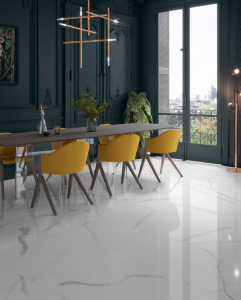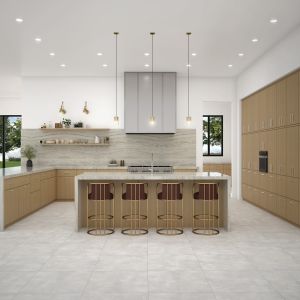
White floor tiles have long been a staple in interior design—known for brightening up any space and creating a sense of openness. That's why they're a popular choice not just for, but also for interior designers, contractors, and DIY enthusiasts.
Indeed, white floor tiles might be that "prom king" who always steals the night. But it can also be that drunk party-goer who shows up in a Hawaiian shirt and captures everyone's attention for the wrong reason. It's just different from the scene you wanted to see.
If you're wondering whether white kitchen floor tiles would even work for you, you might want to continue reading this article.
In this comprehensive guide, we'll explore everything you need to know about white kitchen floor tiles—from their benefits and drawbacks to expert tips for buying and cleaning.
Are white floor tiles a good idea in the kitchen?
Imagine this: You're hosting a lively family gathering. Laughter dances through the air as grandchildren scamper across the cool, white kitchen floor tiles, leaving a trail of tiny muddy footprints.
The dog, ecstatic with the number of guests, adds its paw prints, dusted with flour from earlier baking escapades. Meanwhile, you and your family weave between them, arms laden with platters and bowls, adding your share of flour-kissed marks.
Sounds fun, right? Not so fast, when the idyllic fades and reality sets in—those pristine white floor tiles, once gleaming like fallen snow, now resemble a post-war zone. Every footstep, every spill, becomes a stark reminder of the high-maintenance nature of your choice.
Cleaning becomes a constant chore if you have a large kitchen with white tiles. Keeping those white tiles spotless requires frequent mopping and scrubbing, especially in a large kitchen with more movement.
Spills of colorful sauces, splatters of red wine, and even tracked-in mud becomes usual. White surfaces highlight scratches and scuffs more readily, making even minor wear and tear stand out.
Of course, this isn't a knockoff against all-white kitchen floors. If you have a smaller kitchen with controlled traffic, white tiles can create a bright and airy feel.
But for a large, bustling kitchen, especially one with frequent pet or child activity, opting for a more forgiving floor color might save you countless hours of scrubbing and a constant sense of battling against the inevitable.
Why still choose white tiles for your kitchen floors? Let’s find out!
Pros of White Kitchen Floor Tiles
In the context of large kitchen spaces, you learned why white tiles are a bane for aesthetics and maintenance.
White floor tiles are unforgivingly prone to showing dirt, stains, and scratches, demanding frequent cleaning and maintenance. Additionally, exposure to sunlight, chemicals, and moisture can cause yellowing over time, necessitating periodic repainting or replacement.
Furthermore, their smooth surface can become dangerously slippery when wet, posing a safety risk—especially in households with children or elderly individuals.
But enough about the cons—let’s start by exploring the many benefits of white floor tiles:
Illusion of Space
One of the most significant advantages of white tiles is their ability to reflect light and create the illusion of more space. Furthermore, white tiles can also work wonders in smaller or darker kitchens, making your room feel larger, brighter, and more open.
This means that in terms of light reflection, white tiles bounce light—creating an airy ambiance and making your kitchen appear more expansive. Regarding color simplicity, white’s purity and lack of strong contrast visually extend its boundaries more than you ever imagined.
According to one study, one of the psychological benefits of the color white is that "It has a decluttering effect and can make small spaces seem bigger, which can help stimulate your creativity and make you feel more refreshed and organized."
In addition, white tiles have a minimalist effect: They reduce visual clutter, allowing the other design elements in your kitchen to shine. Another feature of theirs is that a consistent white surface unifies a room—enhancing its spaciousness.
Finally, white tiles boost the brightness of your kitchen: They brighten dim areas—transforming, or giving, if you may, its overall feel into a relaxing and heavenly vibe.
Versatile Aesthetics
White tiles are versatile and can complement any design style—from classic to contemporary. Whether your kitchen features sleek modern cabinetry or traditional farmhouse charm, white tiles will enhance its aesthetic appeal.
Why? The reason is pretty simple: white tiles have an adaptable charm. Psychological research shows that their color can be "calming and peaceful.”
In other words, they seamlessly blend with any design style—classic, modern, or farmhouse. Hence, their neutrality allows them to enhance the overall aesthetic of your kitchen, regardless of the existing decor.
Wide Range of Options
Regarding white kitchen floor tiles, the possibilities are virtually endless. From classic ones and elegant marble to trendy subway and hexagon shapes, a white tile suits every taste and budget.
For instance, classic porcelain tiles are timeless and durable, offering a clean and versatile look. They're even perfect for both traditional and modern kitchens. On the other hand, marble tiles are an excellent choice if you seek sophistication. Their natural veining also adds a touch of luxury to any space.
Moreover, subway tiles—with their rectangular shape—evoke a chic urban vibe. They're popular as well for creating stylish backsplashes or entire walls. On the other side of the coin, hexagonal tiles bring geometric flair to your kitchen. So, whether small or large, they'll infuse character into your kitchen design.
Nonetheless, these five expert tips for choosing the ideal porcelain tiles may help provide more information.
Tips to Choose the Best White Tiles for Kitchen Floors
Knowing the pros and cons of white floor tiles, you might have already decided—you’re going for white kitchen floors! But before you hit that “Add-to-cart” button, let's explore some expert tips for choosing the best ones for your space.
Consider Material and Durability
When selecting white tiles for your kitchen floor, consider material, durability, and maintenance requirements. Porcelain tiles are an excellent choice for high-traffic areas, as they are durable, water-resistant, and easy to clean.
Porcelain tiles are made from dense clay fired at high temperatures—resulting in a hard, non-porous surface. They resist stains, scratches, and moisture, making them ideal for high-traffic areas. Additionally, they come in various finishes (matte, polished, textured) to suit your aesthetic preferences.
For durability, conversely, porcelain tiles withstand heavy foot traffic without showing signs of wear. Porcelain tiles boast a high breaking strength, typically exceeding 2,000 pounds per square inch (PSI). This means they can withstand significant weight without cracking or breaking.
This is significantly higher than that of common tile materials like ceramic (less than 1,000 PSI) or even natural stone like granite (1,000-2,000 PSI).
Furthermore, porcelain is inherently water-resistant—making it suitable for kitchens like yours where spills and splashes occur frequently. Finally, porcelain tiles can handle dropped utensils or pots without chipping or cracking. Porcelain remains stable even in extreme temperature fluctuations, as a study shows.
Nevertheless, choosing suitable flooring tiles might help complete your dream kitchen space that can endure the passage of time.
24x24 Calacatta Square White Porcelain Floor Tile from the Marble Attache collection.
Factor in Size and Pattern
The tiles' size and pattern can significantly impact your kitchen's overall look and feel. Larger tiles can create a sense of continuity and spaciousness, while intricate patterns add visual interest and texture.
In terms of having a small kitchen space, opting for larger format tiles can create a sense of continuity for your kitchen. When these tiles cover a significant area, they minimize grout lines—making your space appear more expansive. Consider large-format rectangular tiles or square tiles for a seamless look.
And yet, smaller tiles, such as mosaics or subway tiles, can add texture and visual interest. They break up large surfaces and create a dynamic backdrop. Use them as accents or in specific areas like backsplashes.
The most common tile pattern is straight lay, where tiles are laid in a straightforward grid. It's clean and timeless. In addition, the herringbone pattern is the diagonal arrangement of rectangular tiles in a tile—creating a zigzag effect. It even adds movement and sophistication.
Moving further, the tiles with basketweave design have interlocking rectangular tiles resembling a woven basket. They're ideal for classic or vintage aesthetics. Additionally, the herringbone is chevron but with a V-shaped pattern. It's even modern and eye-catching.
Lastly, the random staggered design portrays the irregular placement of tiles—creating an organic feel. It even works well with natural stone or rustic tiles.
Are you a fan of concrete floors? This beginner's guide to concrete-look porcelain tiles can provide you with the best information.
Coordinate with Kitchen Elements
Remember to consider other kitchen elements—such as cabinetry, countertops, and appliances—when choosing white tiles. Opt even for tiles that complement or contrast with these elements to create a cohesive and harmonious design scheme.
Here’s how you play with your kitchen space with white porcelain tiles.
Cabinetry harmony: White tiles can clash with dark wood cabinets, creating a stark contrast. Opt for lighter cabinets or warmer-toned tiles for a cohesive look. Pair white tiles with white shaker cabinets in a soft, creamy hue for a light and airy feel. This creates a seamless flow and maximizes natural light.
Countertop connection: Cool white tiles might not jive with warm granite countertops. Seek color harmony or create a bold contrast, but ensure it feels intentional. Embrace warmth by pairing cool white tiles with dark countertops like black soapstone, brown Soil Square porcelain tile, or a gray Zion Picket glossy tile from Daltile. This creates a dramatic and striking contrast, perfect for modern kitchens.
Appliance alliance: Stainless steel appliances can complement cool white tiles, while black or colorful appliances might need a different tone.
Sample, sample, sample: Before committing, see how white tiles interact with your existing finishes under different lighting conditions.
Where to Find Kitchen Floor Tiles in California
White kitchen floor tiles offer a timeless and elegant choice for any kitchen but require careful consideration.
By weighing the pros and cons and following our expert tips, you'll be well-equipped to make an informed decision.
To transform your kitchen with stunning white floor tiles, explore Otile’s extensive collection of premium tiles. This collection includes porcelain, marble, and more. With our vast range of options and expert guidance, you're sure to find the perfect flooring solution for your home.
Visit us today to explore our premium selection of kitchen floor tiles and embark on your renovation journey with confidence.


Written by:
Ali Eftekhari
Results-driven MBA Professional with 15+ years in the stone, slab, and tile industry.
Expert in strategy, operations, and global relations. Extensive international experience in Brazil, China, India, Turkey, Peru, and the USA.

















Login and Registration Form